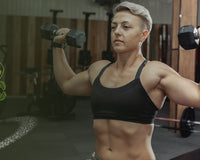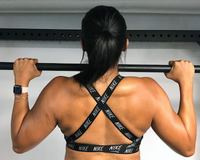
The Cossack squat is one of the best squat variations. Designed to be performed in a slow, controlled fashion, this exercise will increase the mobility in your hips and help you build serious leg strength.
The best part is there is no equipment needed!
Muscles Worked By The Cossack Squat
Primary Muscle Groups:
The Cossack squat primarily works the quadriceps and the glutes. The four muscles in the front of your leg that comprise the quadriceps are the rectus femoris, vastus intermedius, vastus medialis, and the vastus lateralis.
Not only does the Cossack squat increase hypertrophy in these muscle cells, it provides a deep stretch to the quads as well.

In addition, the glutes receive a significant amount of tension during the Cossack squat. The gluteus maximus, medius, and minimus make up the gluteal muscles. While this exercise targets all three muscles of the glutes, the gluteus maximus and medius are most engaged during the movement.
The Cossack squat guarantees a very strong contraction of the gluteal muscles.

The last primary muscle group worked by the Cossack squat is the adductor muscles: the adductor brevis, adductor longus, adductor magnus, and the sartorius. These muscles originate in the pelvic region and are responsible for bringing your legs towards the center of your body.
The Cossack squat adductor exercise especially contracts the muscles that help to flex your hip joint.

Secondary Muscle Groups:
The Cossack squat secondarily works the core and the hamstrings. As you lower to the floor, your core is responsible for stabilizing your body to maintain your balance. Your hamstrings play a similar role in the motion.
When you perform the Cossack squat, your hamstrings support your quadriceps by reinforcing the lower part of your leg to help you complete the exercise with proper form.
Cossack Squat Benefits
1. Strength Gains
When our muscles are stressed, small, individual fibers tear and then rebuild themselves to be stronger than before. The Cossack squat places a great stress on your quadriceps, glutes, and hips.
These muscles are important for explosive movements such as running, jumping, or other exercises like the traditional squat or deadlift. Maintaining and increasing lower body strength is essential for daily activities as well.
Whether you are a weightlifting record holder or someone completely new to fitness, a strong lower body provides a stable base that you can rely upon to accomplish your goals.
2. Improved Range of Mobility
In pursuing strength, it can be easy to ignore flexibility or mobility. Ironically, when we neglect to improve our range of mobility, we actually limit our strength potential.
The Cossack squat forces us to squat deeper than almost all other squat variations. This opens up the hip joints and improves lower body flexibility.
When we lengthen our muscles through stretching, we are able to activate a greater quantity of muscle fibers during exercise. In short, this means we can lift more weight, jump higher, and run further!
3. Improved Muscle Imbalances
While you can train both legs equally with the Cossack squat, you can also use this exercise to train one leg at a time. If one of your legs is stronger than the other, you can use this exercise to even out your muscle imbalances.
How To Do The Cossack Squat
Equipment:
To perform the Cossack squat, all you need is your body weight. However, if you want to increase the resistance, you can use a dumbbell or a kettlebell. See the variations below for more information.
Setup:
a) Start from a standing position with your feet spread far apart. Adjust your stance until you find the most comfortable position for you
Action:
a) Shift your weight to one foot as you slowly lower yourself to the ground.
b) Keep the heel of your plant foot on the ground but allow the toes on your other foot to flare upwards.
c) Contract your glutes to drive up to the starting position. Repeat!

Recommendation:
The Cossack squat may seem challenging at first. Perform 3-4 sets of 12-15 repetitions to become comfortable with the form. If you are using weight, do 6-8 repetitions per set.
Cossack Squat Mistakes
1. Leaning Too Far Forward
It is important to keep your weight back during the Cossack squat. You should feel as though you are sitting back into your glutes to maintain proper form and balance during the exercise.
2. Rounding Of The Back
Try to keep your back straight while performing this exercise. Rounding your back during the Cossack squat will place unwanted stress on your spine. In addition, rounding your back can cause you to lean too far forward!
3. Moving Too Quickly
The Cossack squat is not meant to be an explosive motion. Moving too quickly will compromise your form and potentially risk injury. Instead, be sure to perform this exercise in a slower, controlled fashion.
Cossack Squat Variations
1. Weighted Cossack Squat
If you feel as though you have mastered the Cossack squat, try adding some weight. Grab a relatively light dumbbell or kettlebell and perform the squat with the same form.
This will add an isometric contraction to your arms and further tension to your core.

2. Seated Cossack Squat
The seated Cossack squat is the most challenging Cossack squat variation, as it demands advanced flexibility and leg strength. Slowly lower your body until you sit on the floor at the bottom of the rep. To begin, you can use your hands to push yourself back into the starting position.
However, over time, you should be able to use your glutes and legs to raise yourself off the ground to the starting position.

Cossack Squat Alternatives
If you enjoyed the Cossack squat, check out these other leg and glute exercises to improve your lower body training:
1. Bulgarian Split Squat
The Bulgarian split squat serves as a great exercise to stretch your hip flexors. It also directly targets your glutes, quads, and hamstrings. With one foot elevated, engage your core and squat downwards.
Be sure to keep your back straight during this exercise!

2. Side Lunge (weight optional)
The side lunge also engages your quads and glutes.
Assume a standing position with your toes slightly flared out and your feet wider than shoulder width apart. Keeping your left leg straight, bend your right knee and shift your weight to your right side.
Then, transition to the starting position and repeat on the left side.
Keep switching legs!

3. Toe Down Pulses
The leg pulse is a fantastic bodyweight leg exercise. Place your hands shoulder width apart on all fours and brace your abs. Now, activate your glutes as you pulse one leg up and down. Repeat!

Join the Invasion!
This Anabolic Aliens membership will grant you access to workout classes, rehab programs, diet plans, and more exclusive content to help you achieve sustainable success!










